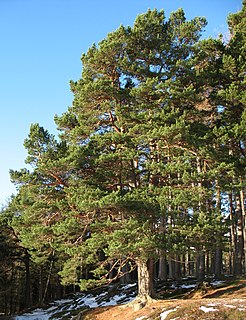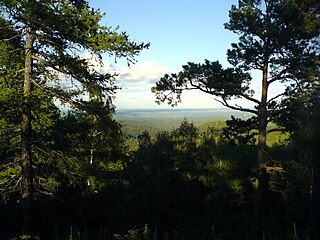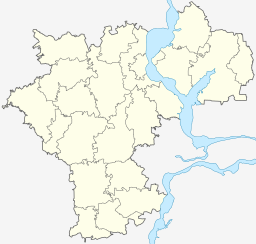
Taiga, also known as boreal forest or snow forest, is a biome characterized by coniferous forests consisting mostly of pines, spruces, and larches.

Pseudotsuga menziesii is an evergreen conifer species in the pine family, Pinaceae. It is native to western North America and is known as Douglas fir, Douglas-fir, Oregon pine, and Columbian pine. There are two varieties: coast Douglas-fir, and Rocky Mountain Douglas-fir.

Scots pine is a species of pine that is native to Eurasia, ranging from Western Europe to Eastern Siberia, south to the Caucasus Mountains and Anatolia, and north to well inside the Arctic Circle in Scandinavia. In the north of its range, it occurs from sea level to 1,000 m (3,300 ft), while in the south of its range it is a high altitude mountain tree, growing at 1,200–2,600 m (3,900–8,500 ft) altitude. It is readily identified by its combination of fairly short, blue-green leaves and orange-red bark.

Shiretoko National Park covers most of the Shiretoko Peninsula at the northeastern tip of the island of Hokkaidō, Japan. The word "Shiretoko" is derived from an Ainu word "sir etok", meaning "the place where the earth protrudes".

Pocosin is a type of palustrine wetland with deep, acidic, sandy, peat soils. Groundwater saturates the soil except during brief seasonal dry spells and during prolonged droughts. Pocosin soils are nutrient-deficient (oligotrophic), especially in phosphorus.
Wildfires in the Mari Autonomous Oblast, in the east of European Russia, occurred in the summer of 1921. Damage included 2,660 square kilometres of pine forest burned off, with serious repercussions for industry in the area, already paralyzed by the Povolzhye famine. The wildfires led to 35 human and 1,000 cattle deaths, and 60 villages were destroyed. The effects of the fire were made worse by strong winds.

Sengiley mountains is a national park of Russia.

Wood Pearl is a natural monument.

The Cretaceous steppes with Caragana is a natural monument. It is managed by the Berezovskoe joint-stock company.

Genko's Forest Belt is a system of historic forest belts in Russia's Ulyanovsk Oblast. Planted over a century ago, it is now considered a "natural monument", and is legally protected as one of the protected areas of Ulyanovsk Oblast.

Ostrov Borok is a natural monument listed among the protected areas of Ulyanovsk Oblast in Russia.

Akshuat dendropark is a natural monument

Monterey County in California, U.S., has a commitment to its environment, and more specifically to its forestation, and offsetting the community's carbon footprint. To that end, a number of resources have been committed to preserving and improving this unique ecosystem and its reforestation.

The Morning in a Pine Forest is a painting by Russian artists Ivan Shishkin and Konstantin Savitsky. The bears were painted by Savitsky, but the art collector Pavel Tretyakov effaced his signature, stating that "from idea until performance, everything discloses the painting manner and creative method peculiar just to Shishkin", so the painting is now credited solely to Shishkin.
The mountain pine beetle has killed large numbers of the lodgepole pine trees in the northern mountains of the US state of Colorado. The more recent outbreak of another bark beetle pest, the spruce beetle, is threatening higher-elevation forests of Engelmann spruce. Chemical prevention is effective but too costly for large-scale use. Dead trees increase the incidence of wildfires, and may contribute to climate change as they decay. Uses have been found for the dead wood including composting and in construction, and potentially to make biochar.

Kedrovaya Pad is a nature reserve on the territory of Khasansky District in the south of Primorsky Krai, Russia. As of 2011, it occupies an area of 178.97 square kilometers (69.10 sq mi), about one thousandth of the total area of Primorsky Krai.

Buzuluksky Bor National Park encompasses the Buzuluk Pine Forest, which is the largest grove of isolated high pine trees in the world. It is surrounded by steppes on the East European Plain east of the Volga River and west of the foothills running up to the southern Urals. This makes it an important habitat for scientific study, and is the site of the earliest forest management area in Russia. It is about 70 miles east from the city of Samara, Russia, and 15 km north of the town of Buzuluk, Orenburg Oblast.

Ilmen Nature Reserve is a Russian 'zapovednik' that was created by decree of Vladimir Lenin, in 1920 as a mineralogical nature reserve. It is the site of deposits of many rare-earth minerals - 16 minerals were first discovered here, including Ilmenite, Monazite, Cancrinite, and Samarskite-(Y). There have been over 400 mines in the area over the years. The Reserve's geological museum is one of the largest in Russia. The forest cover is pine and larch forest on low hills of the Ilmensky Mountains and foothill ridges on east side of the south Ural Mountains. The reserve is situated just north and east of the city of Miass, in the Chebarkulsky District of Chelyabinsk Oblast. It is also 20 kkm east of Taganay National Park and 75 km west of Chelyabinsk.

Central Siberia Nature Reserve is a Russian 'zapovednik'. With over 1 million hectares of protected area, it is one of the largest forest reserves in the world. The reserve is located in the middle Yenisei River and Podkamennaya Tunguska River valleys, of the Central Siberian Plateau. Notably, the territory covers both banks of the Yenisei for over 60 km. The reserve is situated in the Turukhansky District of Krasnoyarsk Krai.














